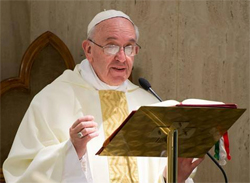During the past 36 years, three Popes with very diverse personalities have led the Vatican, one of the world's largest organizations (in existence for more than 2000 years) through a constantly changing environment and have dealt with a complex variety of internal and external issues that challenged its very sustainability.
Their communications/media relations strategies have drawn cheers and jeers from the world's Catholics.
 |
Poland-born Pope John Paul II, who was chosen in 1978, had a very close, direct-yet fully institutionalized relationship with his PR spokesperson Joaquin Navarro-Valls, a Spanish non-clerical journalist who directed the activities of the Holy See Press Office from 1984 to 2006.
JPII understood the power of visual communication channels, fully recognized and effectively used the power of TV. His multiple, compulsive, when not obsessive, outreach activities strongly influenced, amongst other geopolitical events, the collapse of the Soviet Empire; weakened the Catholic liberation movement in Latin and South America; and reinforced the Church’s engrained resistance to modernity.
This activity was supported by a highly professional and continued use of media relations and constant travel. He visited 129 countries travelling more than one million miles. His global PR skills contributed to his legacy of "the Great Communicator."
JPII'S extended deathwatch marked the longest and most participated public agony in history.
No Time for Reporters
When Benedict XVI succeeded JPII, it was clear the German Pope, a highly refined intellectual, would focus his outreach on theological and doctrinal related issues. He had little interest in and sense of being close to "others."
Pope Benedict was assisted by Father Lombardi, a Jesuit priest who had before been editor of the Jesuit magazine "La Civiltà Cattolica" and also directed the Vatican Radio as well as its Television Centre.
Unfortunately, Lombardi did not have direct and continued access to Pope Benedict. According to a 2010 document released by Wikileaks.org, the lack of closeness between the pope and his spokesperson was an underlying factor of a broader and more complex situation that had led the Vatican on the edge of collapse.
When Pope Benedict announced his decision to exit, no one was expecting that his successor would have so quickly injected such a significant and disruptive impact in guiding the Church to such apparent-at-the-very-least change.
Pope Francis Gets It Right
Now in his second year, Pope Francis continues to use Lombardi's experience in relating with the media and also enrolled Greg Burke, ex-Fox News Vatican correspondent, who had in fact been originally recruited by Benedict.
The choice of hiring an American journalist from Rupert Murdoch's empire was probably to offset American Catholic class action suits tied to the potential financial impacts of paedophilia-related scandals.
The "Francis Effect" is clearly noticeable. Catholics are beginning to returning to the Church, they wait for hours in St. Peter’s square only to see him or hopefully to shake his hand after the celebration of mass.
Even in choosing his own name the Pope took inspiration from St Francis of Assisi, a man of peace and poverty.
He claims that outreach is the Vatican’s core business and that, specifically, the poor of theworld represent the priority stakeholder group.
"Poor Church for the poor" is the new buzzword inside the Vatican walls and, as an example, he was upset in learning that a very exclusive buffet held on the terrace of the Prefecture of Economic Affairs for 150 VIPs during the very recent canonization of Popes John XXIII and John Paul II, had cost 18.000 euros. As Cardinal Giuseppe Versaldi, president of the Prefecture of Economic Affairs reported, "the Holy Father did not appreciate it at all, to use a euphemism."
All the negative and positive verdicts on his first year share similar anecdotes: he is the priest who practices what he preaches: he walks the talk; the 'thumbs-up' gesture indicating that everything's good; the faithful allowed on the Popemobile; the pontiff who lives in a hostel, carries his own bags, is driven round in an old Ford Focus, and makes unexpected phone calls, and loves selfies, embraces the disfigured, invites the homeless for breakfast, suspends bishops with opulent or self-regarding lifestyles and follows a diet of ostentatious frugality.
Pope Francis, who has been named Time's Person of the Year , touted as 'greatest leader' by Fortune, and earned cover boy status in Rolling Stone with an article titled "The Times Are A-changin'" (Bob Dylan).
His pontificate has so far become the most popular in history and the media loves him.
The PR world anxiously awaits Pope Francis' effort to restructure the Vatican's communications shop.
Toni Muzi Falconi is PR adjunct at the Vatican's LUMSA University and from 2006 to 2013/14 at NYU's masters program.
Giovanni Eugenio Tomassetti graduated at Lumsa last year with a thesis on the communicative models of Popes John Paul II and Benedict XVI.
Their paper was presented July 1 at an international history of PR conference at the University of Bournemouth in the UK.


 AB InBev has hired Donna Lorenson as chief communications officer and elevated the PR function to the senior leadership structure in the aftermath of the Bud Light marketing disaster.
AB InBev has hired Donna Lorenson as chief communications officer and elevated the PR function to the senior leadership structure in the aftermath of the Bud Light marketing disaster. Tunheim handled the Minnesota USA World Expo bid committee, which on June 21 congratulated Serbia for landing the 2027 event.
Tunheim handled the Minnesota USA World Expo bid committee, which on June 21 congratulated Serbia for landing the 2027 event. United Minds, management consultancy, has launched Myriant, a business resiliency offering to help clients deal with the challenges during this era of misinformation, polarization and geopolitical upheaval.
United Minds, management consultancy, has launched Myriant, a business resiliency offering to help clients deal with the challenges during this era of misinformation, polarization and geopolitical upheaval.  ImageShield, which guards against online image abuse, is looking for a communications pro to handle its PR and marketing campaigns.
ImageShield, which guards against online image abuse, is looking for a communications pro to handle its PR and marketing campaigns. Who knew that there is a real paper company, Pennsylvania Paper & Supply, inside the iconic building seen at the opening of every episode of “The Office?”
Who knew that there is a real paper company, Pennsylvania Paper & Supply, inside the iconic building seen at the opening of every episode of “The Office?” 


 Have a comment? Send it to
Have a comment? Send it to 
No comments have been submitted for this story yet.